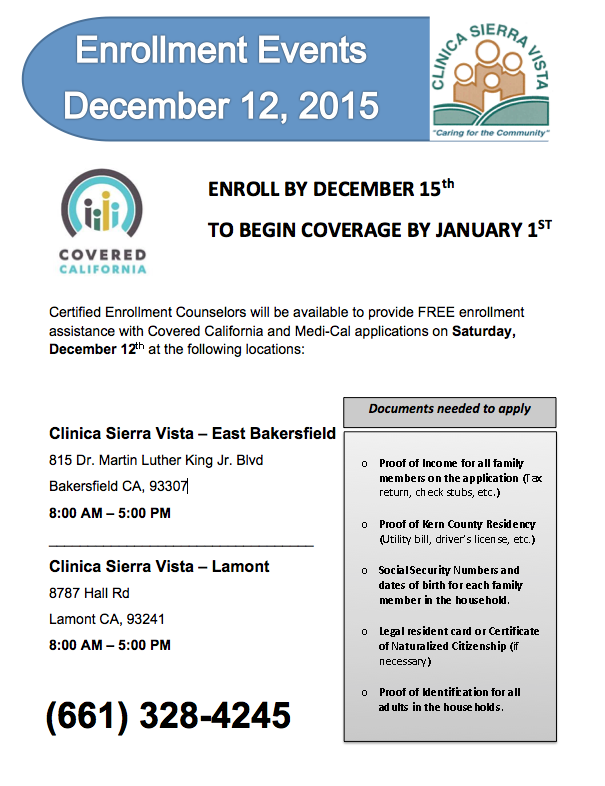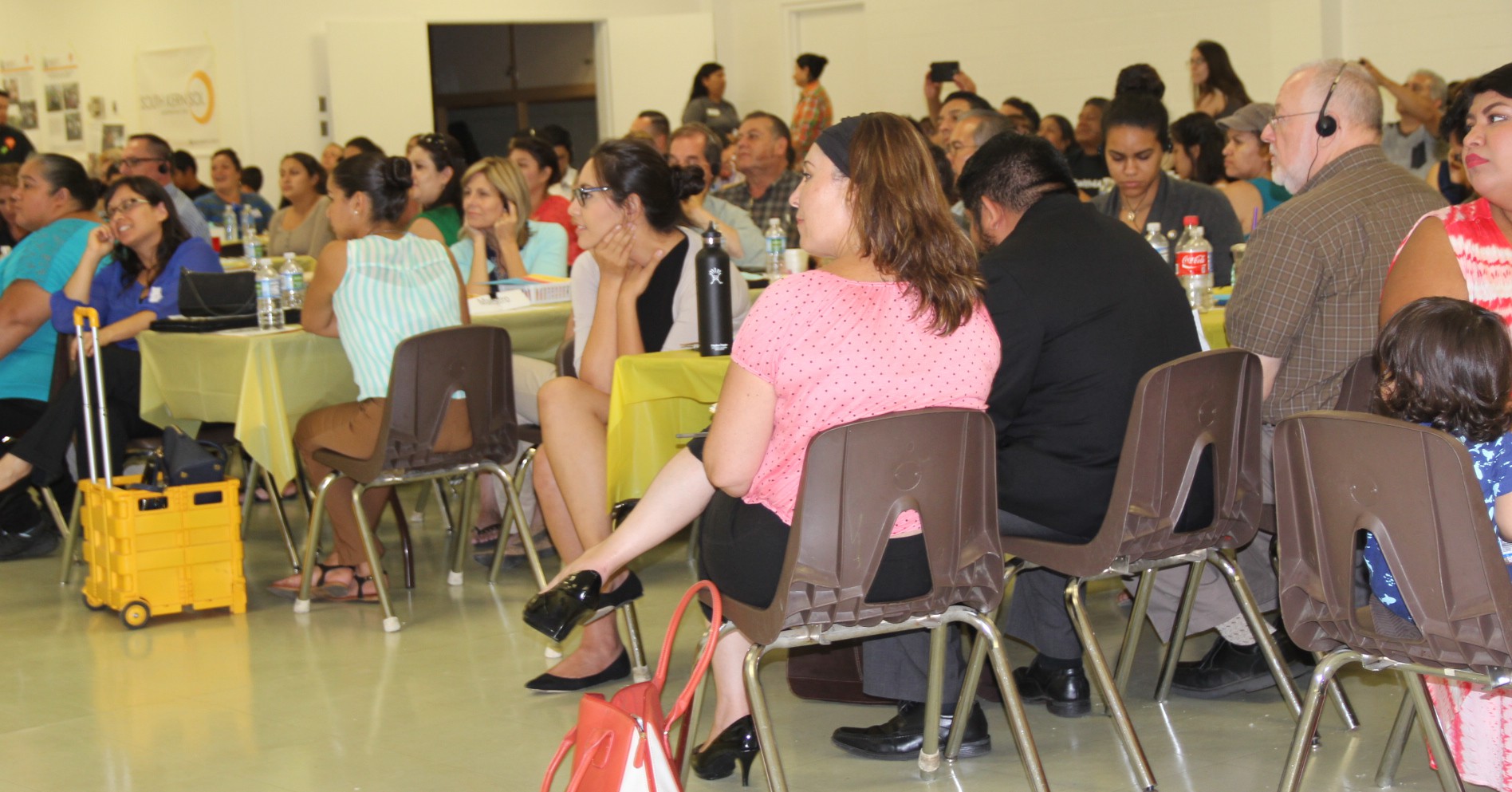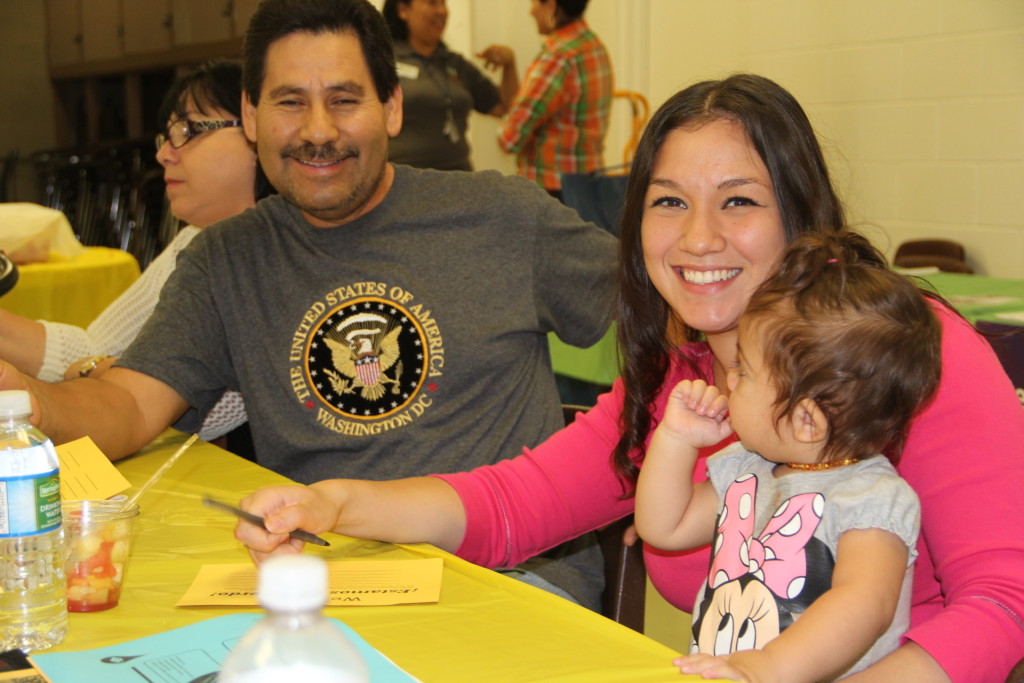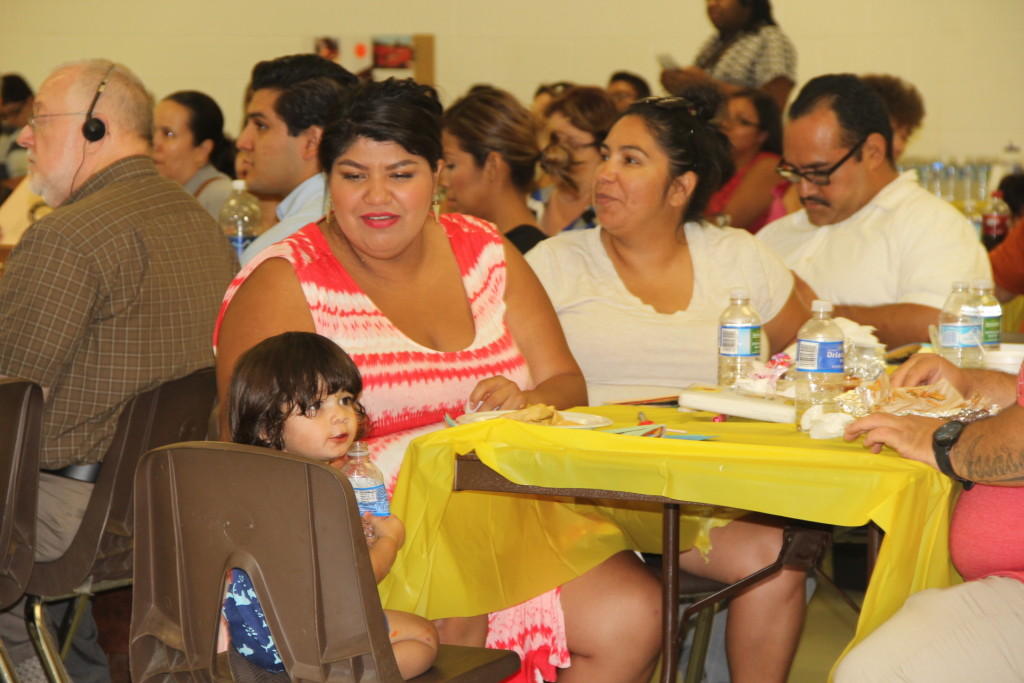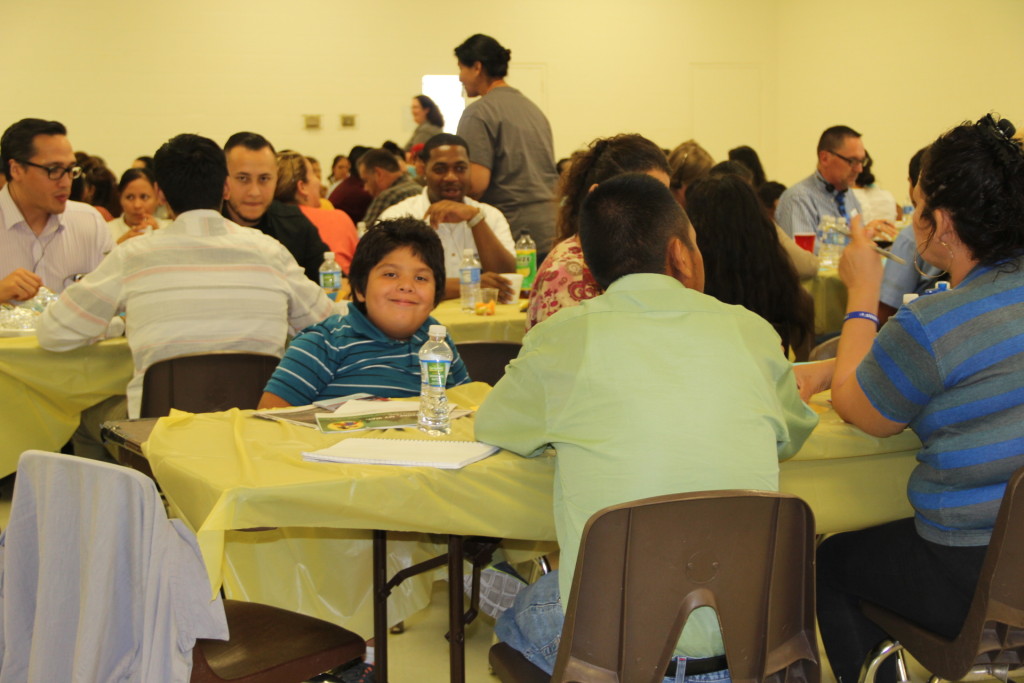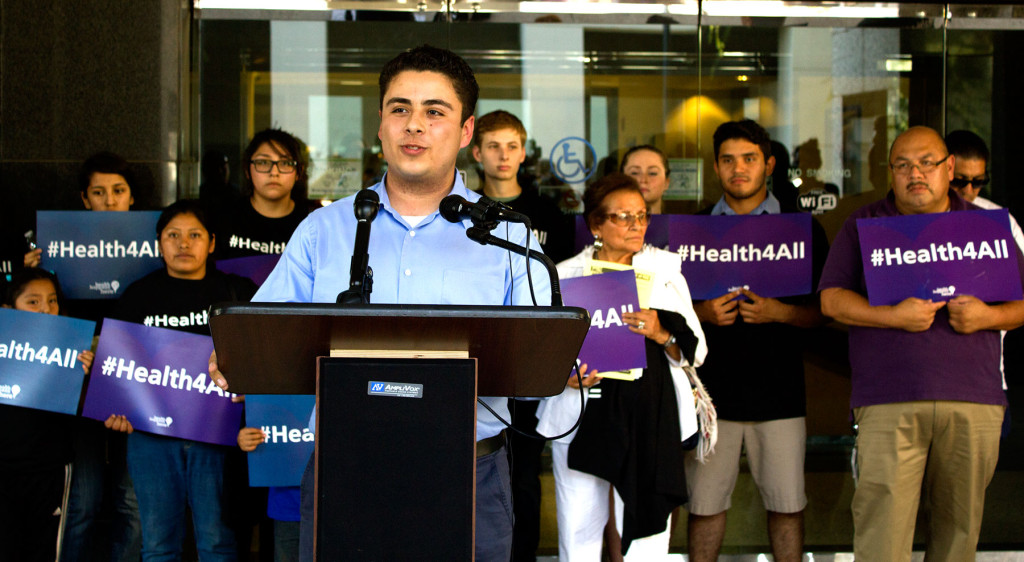Clinica Sierra Vista will be hosting two Covered California enrollment events on December 12, 2015, one in Lamont and the other in East Bakersfield. These events are open to the public and no appointments are necessary. Please call 328-4245 for more information.
Join Building Healthy Communities South Kern’s Recreation Action Team this Friday for a Zumbathon event to raise money for the construction of an indoor soccer field in Rexland Acres Park!
The suggested donation is $5 dollars and all proceeds will go towards the construction of the indoor soccer field.
The event is this Friday, Oct. 30 from 6 to 8 p.m. at Rexland Acres Park in Bakersfield.
Come out to this fun event and support a great cause!
For more information please call Gema Perez at (661) 742-6679.
South Kern Sol, News Report, Randy Villegas
Nearly two hundred South Kern residents gathered at the David Head Center in Lamont this past Thursday for Building Healthy Communities-South Kern ‘Central Table.’ Held every three months, last week’s meeting allowed residents to voice their thoughts one last time on the coalition’s proposed action plan for the next five years. Residents were bused in from Greenfield, Arvin and Weedpatch for the meeting to review and vote on the approval of the draft action plan.
As South Kern residents arrived they gathered cheerfully with their families at the entrance of the David Head Center in Lamont while they waited for their turn to sign-in.
Each of BHC-SK’s four action teams presented their respective five year plans in a fun and interactive ways, including role-playing aspects of proposal. To inform the community that one of their priorities for the next five years is to advocate for healthier meals in schools, one Education Action team member portrayed a student who was eating a bag of chips, then a ‘teacher’ arrives and replaces it for a bowl of grapes.
After each action team presented, the residents were instructed to sign their name on a yellow card if they agreed with the action teams priorities or to sign their name on a blue card if they wanted to suggest changes. After the meeting we followed up with BHC-SK and learned that the action plan was approved and implementation will begin in January.
Education Action Team co-chair Frank Ramirez spoke to South Kern Sol about the team’s success with their alternative discipline advocacy efforts.
“Now that schools are implementing restorative justice, it can help our students. It’s a great tool to have. It will be one of many options that schools can use and it has some great results,” explained Ramirez, referring to the Kern High School District’s decision to start implementing Positive Behavior Intervention Systems (PBIS), a school discipline method which has been known to reduce suspension and expulsion rates. The group plans to continue influencing more local schools to utilize PBIS.
Additional plans for the years ahead include pushing schools to support young people’s health through additional exercise opportunities and healthier school lunches. The Education Action team also spoke about their aim to help local young adults access higher education.
The Environment team works for cleaner air and water in South Kern as well as equitable land use plans. Specifically they aim to reduce air pollution by expanding buffer zones, particularly around pesticide use near schools, in addition to more consistent monitoring and enforcement of buffer zones and other agriculture practices.
Water is also on the team’s radar: they plan to continue working with regional and state water agencies to find short and long term solutions to access clean and safe drinking water.
“The most important thing is reducing pesticide pollution and improving the air quality,” said Environmental Action Team Chair Gustavo Aguirre. “A lot of community members don’t have the ability to breathe clean air, so one of the main parts of this plan is the reduction of pesticide use.”
The Health Team showcased some of the successes from the past five years, including a brand new clinic to serve the Greenfield community. They were also able to help hundreds get health insurance under the Affordable Care Act, and assisted many elders in gaining health coverage through Medicare.
The health team also celebrated a statewide victory: in May of 2016, California will be the first state to provide healthcare to undocumented children. Despite the win, health leaders emphasized that the fight for #Health4all is not over, as undocumented people over 18 will still not be able to enroll in coverage.
Besides supporting the Health For All campaign, during the next 5 years the team hopes to improve emergency response times to rural South Kern communities, and make sure that patients are able to communicate with healthcare providers who speak their language.
The Recreation Group plans to bring more walking and biking paths to South Kern. Youth testified about how the lack of sidewalks, especially on their routes to by partnering with law enforcement and pushing for additional investment in parks.
“We are going to work with local jurisdictions and advocate for more infrastructure, we hope to work with residents and local government to identify potential funding sources, so that we can make these changes happen,” said Jason Carter of Recreation Action Team. “There’s going to be a lot of good things happening in South Kern.”
To get involved with Building Healthy Communities-South Kern please visit healthysouthkern.org.
South Kern Sol, News Report, Earl Parsons
Photo above: Arvin Mayor Pro-Tem Jose Gurrola, speaking as a private citizen.
A coalition of immigrant rights proponents rallied at the Kern County Board of Supervisors meeting on August 17 to demand that undocumented immigrants in their community be given access to health care.
Before the Board of Supervisors held a public meeting to hear public comment on the 2015-16 fiscal budget, community activists with the #HEALTH4ALL campaign held a press conference at the entrance of the Kern County Administrative Center, urging lawmakers to extend health care rights to immigrants. The campaign is to support two bills sponsored by Sen. Ricardo Lara, D-Bell Gardens — SB 4 and SB 10 – both of which will provide all California residents with access to health care, regardless of their immigration status. The bills are currently making their way through the legislature.
Several county officials also spoke at the press conference.
“Health care for all, regardless of immigration status, is morally the right thing to do, and is fiscally responsible governance,” said Arvin Mayor Pro-Tem Jose Gurrola. He said he was speaking as a private citizen and not as a representative of the Arvin City Council. “Health and disease (do) not discriminate.”
Speaker after speaker pointed out that by providing everyone access to health care, uninsured people could avoid expensive emergency room visits.
“Because of a broken immigration system and a lack of leadership at the federal level, we have millions of people in this country and thousands in this county who are living under the shadows without access to primary and preventive care,” Gurrola said, noting that it costs taxpayers more money in the long run.
Read more here.
Mark your calendars for Vision y Compromiso’s Health and Nutrition Fair early next month, the health fair features samples of nutritious food, health screenings and fun activities for the whole family.
The event will be held Sunday, Sept. 6 from 9 to 2 p.m. at the San Judas Tadeo Parish located at 8409 Gail Marie Drive in Lamont.
Building Healthy Communities-South Kern has partnered with Univision and other community groups to host a naturalization workshop on Sunday at the Friendship House in east Bakersfield.
The group will bring professionals and trained volunteers together to assist lawful permanent residents in completing the application for naturalization.
If you know anyone that might benefit from this workshop, please spread the word!
By Ray Gonzales, Ph.D.
How do you spend $1 billion dollars? That’s the question The California Endowment (TCE), the state’s largest health foundation, had to answer. In 2010, TCE committed $1 billion dollars in a ten-year period, 2010-2020, in a strategic investment in Building Healthy Communities (BHC) in 14 of the state’s highest needs communities. These communities started from Del Norte County near the Oregon border to City Heights near the Mexican border, and included such well-known poverty areas as East Salinas, East Oakland, Southeast Santa Ana, as well as South Kern, made up of Arvin, Lamont, Weedpatch and Greenfield areas.
The 14 BHC sites were selected by the California Endowment using a number of critical indicators—health outcomes such as Type 2 diabetes, among others; poverty rates and employment statistics, and; education attainment of both adults and children of the area. TCE also considered geographic diversity—rural and urban, and ethnic diversity. Another, and important, consideration was any previous grant-making experience of the region, and the capacity of potential grantees to move policy and systems’ agenda. The political will and capacity to organize and develop grassroots leadership was also a significant factor in site selection.
Setting the stage, the state and the entire nation had been hit with the Great Recession of 2008. The California budget was in the tank, and Obama’s Washington was in the grip of political gridlock of historic proportions. By 2010 the state, while still in critical condition, was coming out of intensive care. The California Endowment, again seeing a tremendous need to improve community health, sought to initiate a new and daring program. TCE would improve health delivery systems by moving policies, practices, and power dynamics, to improve the environment, education, and social and economic outcomes. The rationale was that these social determinants of health—like income, education, and neighborhood conditions are often at the root of poor health and health disparities.
The plan was based on the premise that health is much more than just health care, and that whatever success the project had in the 14 communities, the findings and practices would not end in those communities, but be spread throughout the state, and even the nation. And finally, BHC should demonstrate that Just Health is about more than just policy changes—it is about long-lasting civic capacity.
At the midway point of Building Healthy Communities and with an expenditure of nearly half a billion dollars, dramatic changes are seen in targeted communities where numerous citizen organizations and thousands of individuals have had a serious and constructive impact on the education, environment, safety levels, and economic conditions that have all aided in improving the health of the community.

-
South Kern residents gearing up for this year’s “Live the Challenge.” More than 300 residents showed up to run their choice of a 5K or 10K run.
In South Kern, groups pressured the Board of Supervisors to revoke a permit and fine a recycling center, which was a chronic polluter. In Del Norte, Native American groups pressured to have healthy lunches provided for needy school children. In South Los Angeles school officials were forced to change how truancy tickets were used in the school district. And in Richmond, a coalition of Black and Latino organizations opposed the Sheriff’s plan to expand the prison system, and got the Police Chief to oppose the Sheriff and support their proposal for a re-entry program instead.
Many of the conditions in the 14 communities, which are as distinct as rural South Kern or East Oakland, have much in common. With the exception of Del Norte (Native American), Latinos make up the single largest ethnic group at all sites. In Coachella, Boyle Heights and South Santa Ana they are 90 percent. In South Kern they are 79 percent. African Americans make up the largest group (39 percent) in East Oakland and Richmond.
Thirteen sites have large immigrant populations with 54 percent in Central Santa Ana. South Kern has a 61 percent immigrant population, made up of Mexicans, Salvadorans, Guatemalans and East Indians. This is a key figure, not only in these locations, but in all of the sites. The Endowment believes that the Building Healthy Communities sites reflect “the next California,” as in all the 14 sites, ethnic groups are the majority of the population.
Youth Development
The California Endowment has targeted programs specifically for youth. The statistics are ominous: low graduation rates, diminishing economic and academic opportunities, higher rates of diet-related diseases, and a higher incidence of violence are all too common for youth in the BHC sites. Some of the locations among the 14 sites are serious danger zones for youth of the communities. Recent studies in the National Journal indicate that Kern County has the lowest high school graduation rate of Latinos in the country, at only 50 percent. Likewise, it is the lowest in the nation for Latinos with bachelors’ degrees at 5 percent. The educational needs among the residents of South Kern are even more serious than the county averages that lead the nation. What does this say about opportunities for good employment, home ownership, safe neighborhoods for children, and good health in general?
Yet, while the statistics and the past conditions are daunting, it is the youth at many of the BHC sites that are leading the efforts for improvement. They understand that it begins with a good education. Schools serve as hubs for comprehensive change in these rural communities. In South Kern (Arvin, Lamont, Weedpatch, and Greenfield) for example, family resource centers are based at the schools. These are locations familiar and trusted by the residents. This is where they go to access many of the other services provided by BHC. The overriding success of BHC projects is a result of this school to home to individual set up.
Jennifer Wood-Slayton, the hub manager for south Kern, has her offices located at the Lamont School District site. “People feel comfortable coming here. They can access health support, nutrition benefits, and the young people join to get involved in safe parks work, clean air and water monitoring, and much more.”
Much of the work of the BHC youth groups has been dramatic and historic. In Boyle Heights and South Los Angeles, youth are leading and winning the effort to reform school discipline policies. The higher incidence of school suspension of Latino and Black students was challenged by youth organizations. They were successful in getting the school district to change the policy. The Governor of the State has also signed several bills addressing the punitive school discipline issue. In South Kern, youth and community groups are participating in a current lawsuit filed against the Kern High School District for its over-zealous suspension of minority students. This is just another instance where one local issue has spread across the state addressing similar problems.
As one TCE program manager put it, “This wasn’t about an outside organization saying ‘hey system leaders, this is what you should be doing.’ It was the voices of the youth themselves saying this is what I am experiencing, this is what I need.” Students are talking to one another, going to the power brokers—principals, local politicians, school board members, to make their points. They seek to clean up public parks, improve community lighting, provide recreation and learning centers, improve diets for poverty students. South Kern, because it is a rural area that leads the nation in so many negative ways—polluted air, low education levels, lack of health insurance, unemployment and low wage employment, poor health conditions…has a tremendous job ahead of it. But The California Endowment, is aware of this and that is why it was selected as a site for Building Healthy Communities. The work is well underway.
The Goals of Building Healthy Communities
The California Endowment has undertaken a major program—an expansive and inclusive vision for healthy communities in all of California. But getting there with a program that benefits everyone requires starting in the communities with the greatest health disparities. These communities represent the future of California because they are younger than the general population of the region and the state.
Annalisa Robles, a Bakersfield Native and now a Program Manager for the Endowment, travels the state, facilitating partnerships, developing strategy and offering support. She spends a great deal of time in South Kern and is very optimistic. “For far too long, residents of South Kern have experienced generations of poverty, trauma and discrimination. When communities feel marginalized they feel powerless. Through Building Healthy Communities—South Kern, residents and particularly youth are finding their voice to take collective action, hold decision-makers accountable and partner to bring transformative change for all.”
As noted in the beginning, TCE believes that the path to better health goes through a process where improving the education, the social structure, and the economy of these communities is necessary to reach a goal of healthier communities. Clearly, the dollar investment of TCE has already brought thousands of people into the process of participating, as leaders and recipients of the changing and improving conditions. While the project is at mid-way point, it is clear that BHC is off to a tremendously successful beginning. (On other occasions, I will focus on the activities in the targeted communities of Arvin, Lamont, Weedpatch and Greenfield.)
Sources: USC Program for Environmental and Regional Equity, 2014. The National Journal. June, 2015. Kern County Statistical Abstract, 2014. Personal Interviews with project leaders and site visits.
Ray Gonzales, Ph.D., is a retired California State University Professor who also served in the State Legislature; U.S. Diplomatic Service; Director of Recruitment for U.S. Peace Corps, and currently serves on the Bakersfield City School District Board. Over 250 published articles and latest book: A Lifetime of Dissent, 2006.
Building Healthy Communities- South Kern (BHC-SK) has opened its grant program, which awards up to $500 for projects that aim to improve community health in South Kern.
The fourth cycle of grants will fund health-related activities in the communities of South Kern. Funds can be used for materials or supplies, but may not be used to pay for services or the time it takes to complete the projects.
Some of the past recipients have included Mountain View School. The school got very creative and as a way to move away from unhealthy fund raising practices, the school used the funds to purchase four World Cup jerseys to use as prizes for a raffle fundraiser, which replaced one of their yearly candy sales.
“We raised $2,000 from selling raffle tickets to the students, and we donated that money to the Mountain View Student Body account,” said Manuel Ramirez, the teacher at Mountain View School who applied for the mini grant.
The Greenfield Walking Group has been another grantee, which received funding to purchase two speakers to use at the group’s daily Zumba class at Stiern Park in southeast Bakersfield. Regular Zumba classes are bringing outdoor physical activity opportunities to the residents of Greenfield and inspiring people to get off the couch and move.
Applications can be made by any group of residents, youth, or community partners such as parent groups, groups of neighbors, or others. Groups should be from the communities of Arvin, Lamont, Weedpatch, or the unincorporated areas of Greenfield. If you need assistance completing the application, contact Angelica Munoz at (661) 845-2724.
Applications can be found at www.healthysouthkern.org. Applications must be submitted by 5:00 p.m., August 11 to 7839 Burgundy Avenue in Lamont.
BHC-SK is a community initiative comprised of over 2,000 residents, youth, businesses and organizations who are working to improve community health and initiate systemic change by moving policies and practices in the areas of education, environment, recreation and health-access in the communities of Arvin, Lamont, Weedpatch, and the unincorporated areas of Southeast Bakersfield.
Please join us at a public gathering to kick-off the Safe Water Program in Arvin at the Sierra Vista Elementary School Cafeteria on Monday, June 15, from 6-8pm.
We hope you’ll join us at this community event to celebrate the first round of installations of point-of-use treatment systems on water fountains in Sierra Vista Elementary School. These treatment systems, specifically designed to remove arsenic from the water, will be on display. We will have a walking tour to see the systems installed on the fountains and hear from the local community leaders who have supported this project from the beginning. Your strong support and partnership for safe water in your community will result in the local schools, libraries, health clinics, and other community spaces in Arvin getting a total of more than 70 of these treatment systems. Come and try safe water treated by the new point-of-use systems, and be sure to bring your new, reusable Agua4All water bottle! Meet and celebrate the school, community partners, and non-profits that made this happen.
The meeting is hosted by the Rural Community Assistance Corporation and the Community Water Center. This project is funded by the California State Water Resource Control Board, The California Endowment, and Helping Hands for Water.
**Please note that this event will be filmed for an upcoming documentary and we will be asking for waivers to have permission to film participants at the event. If you do not wish to be filmed, let us know and you can be seated in a special section but we would still love for you to attend!
DATE
Monday, June 15
TIME
6-8pm
LOCATION
Sierra Vista Elementary School Cafeteria, 300 Franklin St. Arvin, CA
THANK YOU FOR YOUR CONTINUED SUPPORT!
QUESTIONS?
If you have any questions about the event or this project, please contact Gerardo Tinoco, Jr. at gerardo.tinoco@communitywatercenter.org or call (661) 345-9976.
